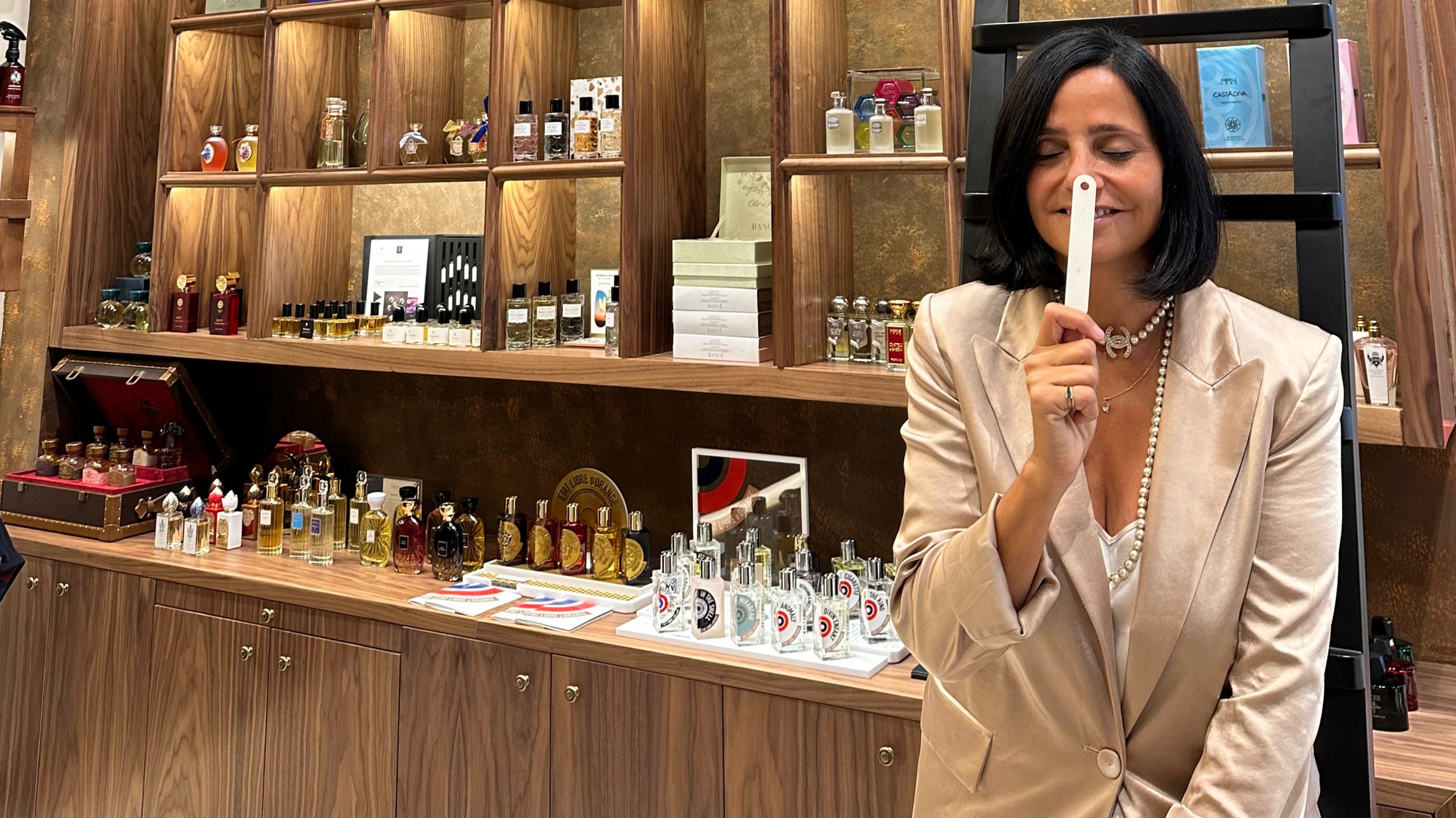


Executive Master’s graduate Alexandra Alves Gaspar is intrigued by the sensory side of luxury; and in this exclusive guest article, she reveals how the nose can be our gateway to a truly immersive luxury brand experience…
I completed my Executive Master’s in Luxury Management and Guest Experience at Glion last year. For my Master’s research project, I chose to concentrate on the sense of smell, a topic I became passionate about, and which is becoming increasingly significant in brand strategies.
The title of my thesis was “What the Nose Knows: Exploring the Invisible Sense in Shaping Luxury Experiences”. In parallel with my thesis, I also developed an olfactory integration handbook outlining how to integrate smell into luxury brand experiences.
Here, especially for The Insider, I present a short, interactive guide to the important role played by our sense of smell. I’ve included some of the guiding principles for using scents in a luxury environment, plus a few examples of olfactory integration within the luxury business.
I hope you find it interesting, and if you’d like to know more you are welcome to get in touch with me via LinkedIn.
__________________________________________

Try this experiment: Pinch your nose, bite a warm, freshly baked pastel de nata, and close your eyes. What do you feel? The flaky, crispy pastry and creamy egg custard on your tongue? Maybe there’s a slightly burnt texture and a hint of sweetness, too. But something is missing…
Now, release your nostrils and breathe out slowly. The delightful scent of vanilla, cinnamon, and custard cream emerges, whisking you back in time and space. In a wink, you’re in Lisbon, on a cozy terrace under the shade of a blooming jacaranda, with a steaming espresso ready to start your day. This is the allure of olfaction – a magical flying carpet that transports you into a treasure trove of memories and emotions.
Smell is not just a nostalgic indulgence. It is electrifying, sensual, and visceral. It reminds us of who we are, our bond with others, and the natural world. It is as profoundly fascinating as humanity itself. Treaties and conquests were made, loves won, and gods worshipped for the sake of perfumes. Smell awakens us, evokes memories, and subtly influences our behaviors, steering us to seek the extraordinary.
Talking about the extraordinary, in times when consumers yearn for deeper ways to live and experience luxury, and brands’ aspirational offerings often go beyond possessions, there is a growing desire for experiences that engage all our senses.
This trend towards multisensory engagement heralds a new and thrilling way to approach luxury avenues. A revolution is indeed in the air, propelled by generations Y, Z, and Alpha. These squads seek experiential brands that cater to their desires, reshaping the industry. The reason is clear: tired of digital overload, they crave more than products or services; they want to immerse in the memories, feelings, and stories associated with those brands.

Captivated by the transformative power of scent, I ventured into this fascinating world in my academic research. And it all began on the Caribbean island of St. Barths, at a fragrant hotel. The aroma – a floral-solar blend with hints of ylang-ylang – was enthralling. As I stepped into the lobby, it embraced me like a delicate whisper. The choice was not coincidental, but purposely aligned with the hotel’s image, ethos, and voice. It permeated the entire space, making the olfactory concept tangible. Even today, a whiff of something similar instantly takes me back to that slice of heaven!
Strategic scent integration to enhance brand experience should not be overlooked. A lovely aroma does more than create a good first impression; it shapes an olfactory signature that enhances customer journeys and builds brand loyalty and equity. Legend or truth, the origin of olfactory branding traces back to Queen Cleopatra. It’s said that her sails were soaked with her perfume, allowing Mark Antony to sense her arrival even before seeing her, winning his heart.
This historical tale illustrates scent’s pivotal role in crafting lasting memories and influencing emotions, much like olfactory branding promises today. But don’t get me wrong: it’s not only ‘promises’. Research shows that olfactory memories have significant staying power, with a 65% accuracy rate for up to a year, compared to rapidly fading visual memories. Olfactory marketing can boost retail sales by 11% and enhance customer satisfaction by 20%. Crucially, emotionally connected customers are 52% more valuable to brands than merely satisfied ones.
But where should brands begin? How can they master the art of olfactory integration and win their customers’ hearts? You just need to memorize the trio of Cs. Ready to dive in nose-first?
Choosing a scent is like conducting a symphony, where Consumers are both conductors and composers. Brands need to offer a masterpiece, not a dissonance. Start by first recognizing that smelling good is more than just an adornment; it should embody the brand’s identity, personality and ethics. Why focus solely on visual identity, tone of voice, and marketing campaigns while neglecting the power of scent?

Investing in experts for olfactory brand identity might sound obvious, but it’s often overlooked. These specialists can uniquely decode and translate a brand into a distinct, authentic scent, deeply understanding your target audience’s cultural, social, and emotional landscape. This is where art meets chemistry. Leave the chemistry to the experts and offer a masterpiece to your clients.
The second ‘C’ is Conceptual fluency. This step ensures your scent is unique and recognizable, yet subtle enough to be inviting rather than overwhelming. It should harmonize the atmosphere, gently infusing the space, event, package, or even your digital experience, becoming a murmured yet integral part of the brand’s sensory tapestry.
At that fragrant hotel in St. Barths, the blend of its notes created a refreshing and grounding scent, echoing the delicate balance of adventure and relaxation and the togetherness of an idyllic getaway. Like the brand, it blended natural beauty with ethereal and mindful elegance.
There’s no right or wrong, but there is Congruence and Consistency. These principles don’t just share their ‘C’, they ensure that the scent’s character aligns with the brand’s essence.
Consider a luxury hotel where the aromas of oud and leather fit perfectly, enhancing the image of exclusivity and sophistication. These notes work wonderfully with luxury lifestyle brands focusing on high-quality, exclusive products like watches, jewelry, and bespoke services. Conversely, an eco-friendly brand may choose herbaceous notes as a signature scent to evoke the freshness of nature, avoiding scents like oud or leather that may not fit its sustainable ethos.
Congruence influences consumers’ well-being and cognitive dimensions, and a signature scent should be a ‘warm welcome’, positioning with the brand’s purpose and atmosphere. Notes of rose and blackcurrant can inspire a springtime freshness and a sweet scent for a new and vibrant brand. Bringing sun-kissed beach vibes, a combination of passionfruit and lime can evoke the essence of a last summer night, perfect for a beach bar. A blend of sandalwood and rose offers a beautiful, nuanced scent, ideal for a high-end dining scene.

For a real-world example of what I’ve outlined, I can reveal that my ‘fragrant hotel’ is Eden Rock – St Barths, and its olfactory collaborator is the legendary perfumier Diptyque. The elegant resort’s signature fragrance, built around the intoxicating ylang-ylang notes, perfectly embodies its essence. The tropical scent aligns with St. Barths’ paradise vibe, while Diptyque’s reputation for high-end fragrances elevates the experience. This synergy creates a unique olfactory signature association that elevates both brands’ core values: luxury, natural inspiration, and exclusivity.
The more I travel into worlds of scents, the more I surrender to their allure. It is one of nature’s oldest, purest, and most powerful tools. And next time you consider changes in your marketing strategy, pause and smell the roses. Let your nose guide you. Embrace Cleopatra’s wisdom: infuse your brand with a unique olfactory signature and set sail towards success and your customers’ hearts.
After all, the nose is an extraordinary luxury compass, always pointing true.
Photo credits
St. Barths: Ljiljana Perisic/Getty
Perfume tester: Maskot/Getty
Immerse yourself in luxury
The Executive Master’s in Luxury Management and Guest Experience from Glion offers flexible, self-paced study that allows you to sharpen your luxury business knowledge without giving up your current role.
















